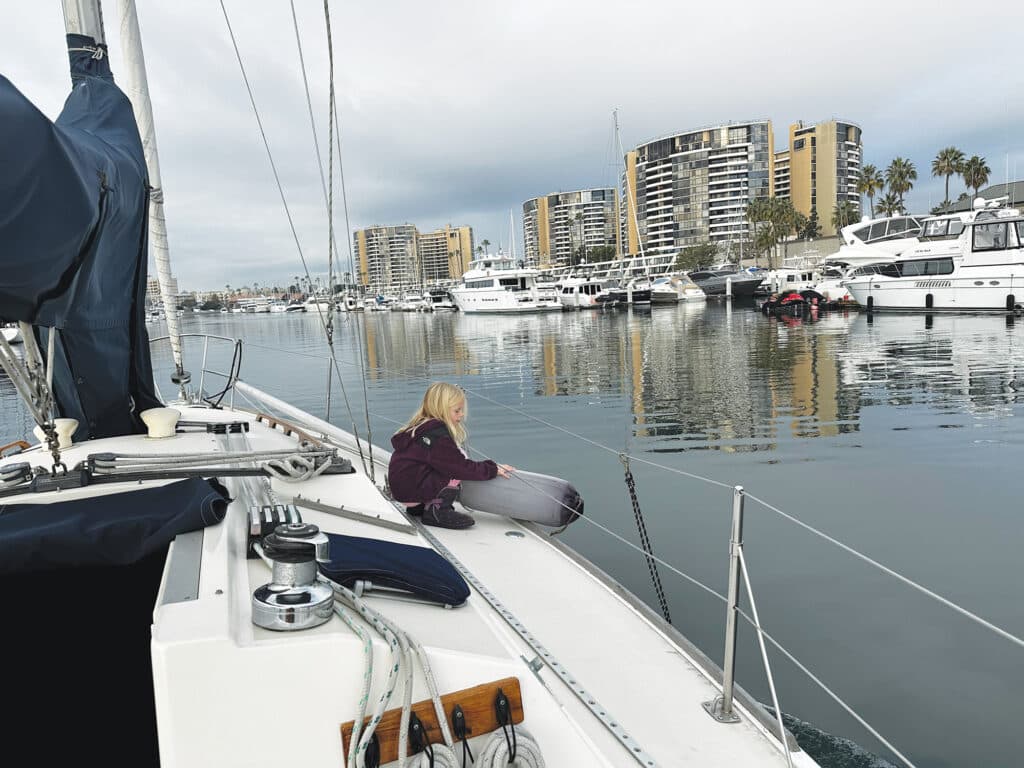
What is it with boats that sail with their fenders out? I’ve observed this apathetic habit nearly everywhere I’ve been on water, but never so much as I see it in Southern California. I have called Los Angeles home for the past eight years. Maybe it’s the old New Englander in me, or perhaps I’m just getting older, but it seems that every year, I see more and more boats underway with their fenders out. They bob from the lifelines like a pair of dirty running shoes dangling from knotted laces on a railing the day after track season ended.
I’m not whining about boats motoring to the fuel dock or headed back to their slip after an afternoon cruise. I’m talking about the boats I see when I am halfway to Catalina, a 30-mile sail from Marina del Rey. Out there, I’ve seen more boats than I can recall sailing hard over with their sails full, rail in the water, and fenders out as if the owner were anticipating a collision with one of the many container ships crossing their bow in the commercial shipping lane.
It’s not like fenders enhance a boat’s aesthetic. And don’t get me started on how many fenders I have seen out during the cruising-class starting line on the Wednesday-night sunset-racing series.
Matty, a dedicated crewmember on my boat for our cruising-class races, calls those dangling fenders “California racing stripes.” He is an Angelino native and, until this past summer, enjoyed the liveaboard life in Marina del Rey for eight years on his 1974 Coronado 35 sailboat. Matty’s coined phrase set the stage for an engaging debate while the rest of our crew laughed, like a sitcom audience, at our passionate opinions about fender etiquette. Matty claimed that stowing fenders was not worth the effort. I’m obsessed with a clean and tidy deck, always.
Unlike Matty, who is a recreational sailor through and through, I used to earn a living crewing and skippering a variety of yachts in places such as New England, the Mediterranean and the Caribbean. I spent much of my career working under sailors of a different generation. The result: I believe anything on a boat that is not in use should be securely stowed.
I argued that leaving fenders out and tied to the lifelines could be a hazard. A jib sheet could unexpectedly snag during a tack or jibe and wrap around a fender. A crewmember could lose his or her footing when rushing up to the foredeck, and maybe trip or even fall overboard.
Stowing the fenders does not require much effort. My 7-year-old daughter, Samantha, is the person on my boat who stows and sets the fenders, and she does a marvelous job. To help make the task easy for her or anyone else pitching in, I fitted each fender with a brass fixed-eye boat snap (an inexpensive stock piece of hardware that is like a carabiner but has an eye cast to the end of it) to the short run of line that is tied to the top of the fender. On a calm day, with my boat secured to the dock, I clipped the brass fixed-eye boat snaps to the lifelines and ran the fender lines through the eyes on the snaps. I lifted the fenders to the desired height, just high enough above the water to keep them dry and prevent marine growth from building up on the bottom of the fender and cover. I knotted each fender line to the corresponding snap with two half hitches so that the fender would always hang from the same height every time.
My lifelines are close to level on my boat, so I set all my fenders to the same height. This way, nobody has to think about which fender goes where, tying knots, or adjusting heights when setting the fenders. Also, the brass fixed-eye boat snap makes for an easy clip-on, clip-off process.
When we depart for a sail, Samantha pulls up each fender and lays it on the deck after we are clear from our dock. Then, she unclips the fenders from the lifelines and carries them back to the cockpit one by one. We have a space in our lazarette reserved for the fenders when we go on our daysails. When we’re out cruising, I lash the fenders to the mast and stow them under our dinghy, which is tied down to our foredeck. When we are moored or anchored, I sit the fenders on our deck up at the bow and lash them to the bow pulpit.
After our sails have been furled and we are heading back to the dock, Samantha works in reverse order. She pulls the fenders out of the lazarette one by one and walks them forward to clip them to the lifelines. To ensure that the fenders are always set in the right location, I wrapped a strip of black electrical tape on the lifelines where each fender should be set.
I also have fender covers, which are well worth the money. I buy dark ones that don’t show much dirt. Without them, the rubber surface of the fenders becomes sticky and collects grime. That grime then rubs off onto my topsides, making for an unpleasant-looking boat.
But sailing with dirty topsides is a whole other topic. Don’t get me started on that one either.
Will Sofrin is an author and wooden-boat builder who has sailed professionally throughout Europe, New England and the Caribbean.








